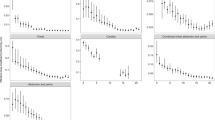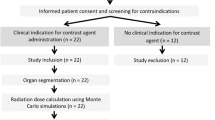Abstract
Objectives
The most accurate method for estimating patient effective dose (a principal metric for tracking patient radiation exposure) from computed tomography (CT) requires time-intensive Monte Carlo simulation. A simpler method multiplies a scalar coefficient by the widely available scanner-reported dose length product (DLP) to estimate effective dose. We developed new adult effective dose coefficients using actual patient scans and assessed their agreement with Monte Carlo simulation.
Methods
A multicenter sample of 216,906 adult CT scans was prospectively assembled in 2015–2020 from the University of California San Francisco International CT Dose Registry and the University of Florida library of computational phantoms. We generated effective dose coefficients for eight body regions, stratified by patient sex, diameter, and scanner manufacturer. We applied the new coefficients to DLPs to calculate effective doses and assess their correlations with Monte Carlo radiation transport-generated effective dose.
Results
Effective dose coefficients varied by body region and decreased in magnitude with increasing patient diameter. Coefficients were approximately twofold higher for torso scans in smallest compared with largest diameter categories. For example, abdomen and pelvis coefficients decreased from 0.027 to 0.013 mSv/mGy-cm between the 16–20 cm and 41+ cm categories. There were modest but consistent differences by sex and manufacturer. Diameter-based coefficients used to estimate effective dose produced strong correlations with the reference standard (Pearson correlations 0.77–0.86). The reported conversion coefficients differ from previous studies, particularly in neck CT.
Conclusions
New effective dose coefficients derived from empirical clinical scans can be used to easily estimate effective dose using scanner-reported DLP.
Clinical relevance statement
Scalar coefficients multiplied by DLP offer a simple approximation to effective dose, a key radiation dose metric. New effective dose coefficients from this study strongly correlate with gold standard, Monte Carlo–generated effective dose, and differ somewhat from previous studies.
Key Points
• Previous effective dose coefficients were derived from theoretical models rather than real patient data.
• The new coefficients (from a large registry/phantom library) differ from previous studies.
• The new coefficients offer reasonably reliable values for estimating effective dose.



Similar content being viewed by others
Abbreviations
- CT:
-
Computed tomography
- CTDI-vol:
-
Computed tomography dose index volume
- DICOM:
-
Digital Imaging and Communications in Medicine
- DLP:
-
Dose length product
- GE:
-
General Electric
- ICRP:
-
International Commission on Radiation Protection
- NCI:
-
National Cancer Institute
- TCM:
-
Tube current modulation
- UCSF:
-
University of California San Francisco
- UF:
-
University of Florida
- WED:
-
Water equivalent diameter
References
IMV Medical Information Division (2021) IMV. 2020 CT benchmark report. IMV Medical Information Division, Des Plaines, Ill
NCRP (2019) Medical radiation exposure of patients in the United States. NCRP Report No. 184. National Council on Radiation Protection and Measurements, Bethesda, MD
National Research Council 2006. Health risks from exposure to low levels of ionizing radiation: BEIR VII phase 2. The National Academies Press, Washington, DC. https://doi.org/10.17226/11340
Kodama K, Ozasa K, Okubo T (2012) Radiation and cancer risk in atomic-bomb survivors. J Radiol Prot 32(1):N51–N54. https://doi.org/10.1088/0952-4746/32/1/N51
Calabrese EJ, O’Connor MK (2014) Estimating risk of low radiation doses - a critical review of the BEIR VII report and its use of the linear no-threshold (LNT) hypothesis. Radiat Res 182(5):463–474. https://doi.org/10.1667/RR13829.1
Lee C, Kim KP, Bolch WE, Moroz BE, Folio L (2015) NCICT: a computational solution to estimate organ doses for pediatric and adult patients undergoing CT scans. J Radiol Prot 35(4):891–909. https://doi.org/10.1088/0952-4746/35/4/891
Jansen JT, Shrimpton PC (2016) Development of Monte Carlo simulations to provide scanner-specific organ dose coefficients for contemporary CT. Phys Med Biol 61(14):5356–5377. https://doi.org/10.1088/0031-9155/61/14/5356
(2007) The 2007 Recommendations of the International Commission on Radiological Protection. ICRP publication 103. Ann ICRP 37(2–4):1–332. https://doi.org/10.1016/j.icrp.2007.10.003
Lee C, Lodwick D, Hurtado J, Pafundi D, Williams JL, Bolch WE (2010) The UF family of reference hybrid phantoms for computational radiation dosimetry. Phys Med Biol 55(2):339–363. https://doi.org/10.1088/0031-9155/55/2/002
Geyer AM, O’Reilly S, Lee C, Long DJ, Bolch WE (2014) The UF/NCI family of hybrid computational phantoms representing the current US population of male and female children, adolescents, and adults–application to CT dosimetry. Phys Med Biol 59(18):5225–5242. https://doi.org/10.1088/0031-9155/59/18/5225
Stepusin EJ, Long DJ, Ficarrotta KR, Hintenlang DE, Bolch WE (2017) Physical validation of a Monte Carlo-based, phantom-derived approach to computed tomography organ dosimetry under tube current modulation. Med Phys 44(10):5423–5432. https://doi.org/10.1002/mp.12461
Long DJ, Lee C, Tien C et al (2012) Monte Carlo simulations of adult and pediatric computed tomography exams: validation studies of organ doses with physical phantoms. Med Phys 40(1):013901. https://doi.org/10.1118/1.4771934
Huda W, Ogden KM, Khorasani MR (2008) Converting dose-length product to effective dose at CT. Radiology 248(3):995–1003. https://doi.org/10.1148/radiol.2483071964
Lee C (2020) How to estimate effective dose for CT patients. Eur Radiol 30(4):1825–1827. https://doi.org/10.1007/s00330-019-06625-7
American Association of Physicists in Medicine (AAPM), The measurement, reporting, and management of radiation dose in CT: report of AAPM Task Group 23 -- CT dosimetry. Report No. 096. Alexandria, VA: American Association of Physicists in Medicine, 2008. https://doi.org/10.37206/97 ISBN: 978-1-888340-73-0.
Huda W, Magill D, He W (2011) CT effective dose per dose length product using ICRP 103 weighting factors. Med Phys 38(3):1261–1265. https://doi.org/10.1118/1.3544350
Shrimpton PC, Hillier MC, Lewis MA, Dunn M (2006) National survey of doses from CT in the UK: 2003. Br J Radiol 79(948):968–980. https://doi.org/10.1259/bjr/93277434.Erratum.In:BrJRadiol.2007Aug;80(956):685.Dosageerrorinarticletext
Deak PD, Smal Y, Kalender WA (2010) Multisection CT protocols: sex- and age-specific conversion factors used to determine effective dose from dose-length product. Radiology 257(1):158–166. https://doi.org/10.1148/radiol.10100047
Chu PW, Yu S, Wang Y et al (2022) Reference phantom selection in pediatric computed tomography using data from a large, multicenter registry. Pediatr Radiol 52(3):445-452. https://doi.org/10.1007/s00247-021-05227-0
Smith-Bindman R, Chu P, Wang Y et al (2020) Comparison of the effectiveness of single-component and multicomponent interventions for reducing radiation doses in patients undergoing computed tomography: a randomized clinical trial. JAMA Intern Med 180(5):666–675. https://doi.org/10.1001/jamainternmed.2020.0064
Smith-Bindman R, Wang Y, Chu P et al (2019) International variation in radiation dose for computed tomography examinations: prospective cohort study. BMJ 364:k4931. https://doi.org/10.1136/bmj.k4931
Smith-Bindman R, Yu S, Wang Y et al (2022) An image quality-informed framework for CT characterization. Radiology 302(2):380-389. https://doi.org/10.1148/radiol.2021210591
Li X, Samei E, Williams CH et al (2012) Effects of protocol and obesity on dose conversion factors in adult body CT. Med Phys 39(11):6550-71. https://doi.org/10.1118/1.4754584
Romanyukha A, Folio L, Lamart S, Simon SL, Lee C (2016) Body size-specific effective dose conversion coefficients for CT scans. Radiat Prot Dosimetry 172(4):428–437. https://doi.org/10.1093/rpd/ncv511
Yanch JC, Behrman RH, Hendricks MJ, McCall JH (2009) Increased radiation dose to overweight and obese patients from radiographic examinations. Radiology 252(1):128–139. https://doi.org/10.1148/radiol.2521080141
Alqahtani SJM, Welbourn R, Meakin JR et al (2019) Increased radiation dose and projected radiation-related lifetime cancer risk in patients with obesity due to projection radiography. J Radiol Prot 39(1):38-53. https://doi.org/10.1088/1361-6498/aaf1dd
Funding
This study received funding by the US National Institutes of Health (R01-CA181191) and the Patient-Centered Outcomes Research Institute (CD-1304-7043 and DI-2018C1-11375). Funders had no role in study design, collection, analysis, interpretation, and reporting of data, or decision to publish. The views in this article are solely the responsibility of the authors and do not necessarily represent the views of the Patient-Centered Outcomes Research Institute, its Board of Governors or Methodology Committee, or other funders.
Author information
Authors and Affiliations
Corresponding author
Ethics declarations
Guarantor
The scientific guarantor of this publication is Rebecca Smith-Bindman.
Conflict of interest
The authors of this manuscript declare relationships with the following companies: Dr. Smith-Bindman is a co-founder of Alara Imaging, a company focused on collecting and reporting radiation dose and imaging quality information for computed tomography. Alara had no role in the study, and Dr. Smith-Bindman has not received funding from Alara Imaging. Other authors have no relationships with Alara and no conflicts of interests relevant to this article to disclose.
Statistics and biometry
Multiple authors have significant statistical expertise, and no complex statistical methods were necessary for this paper.
Informed consent
The UCSF Committee on Human Research provided a waiver of individual informed consent. Collaborating institutions obtained local Institutional Review Board approval or relied on the UCSF approval to contribute data to the Registry.
Ethical approval
Institutional Review Board approval was not required because the paper uses anonymized data.
Study subjects or cohorts overlap
Some study subjects or cohorts overlap with several studies that use the same dose registry, but for different purposes, including:
Chu PW, Yu S, Wang Y, et al Reference phantom selection in pediatric computed tomography using data from a large, multicenter registry. Pediatr Radiol. 2022 Mar;52(3):445–452. https://doi.org/10.1007/s00247-021-05227-0. Epub 2021 Dec 6. PMID: 34866159; PMCID: PMC8857172.
Smith-Bindman R, Chu P, Wang Y, et al Comparison of the effectiveness of single-component and multicomponent interventions for reducing radiation doses in patients undergoing computed tomography: a randomized clinical trial. JAMA Intern Med. 2020 May 1;180(5):666–675. https://doi.org/10.1001/jamainternmed.2020.0064. PMID: 32227142; PMCID: PMC7105953.
Smith-Bindman R, Wang Y, Chu P, et al International variation in radiation dose for computed tomography examinations: prospective cohort study. BMJ. 2019 Jan 2;364:k4931. https://doi.org/10.1136/bmj.k4931. PMID: 30602590; PMCID: PMC6314083.
The CT data derive from the UCSF International CT Dose Registry, some parts of which have been used in prior publications, including approximately 1 million CTs in a randomized trial to assess whether participation in a learning collaborative results in meaningful reduction in radiation doses.
Methodology
• prospective
• observational
• multicenter study
Additional information
Publisher's Note
Springer Nature remains neutral with regard to jurisdictional claims in published maps and institutional affiliations.
Philip W. Chu and Cameron Kofler are joint first authors.
Wesley E. Bolch and Rebecca Smith-Bindman are joint senior authors.
Supplementary Information
Below is the link to the electronic supplementary material.
Rights and permissions
Springer Nature or its licensor (e.g. a society or other partner) holds exclusive rights to this article under a publishing agreement with the author(s) or other rightsholder(s); author self-archiving of the accepted manuscript version of this article is solely governed by the terms of such publishing agreement and applicable law.
About this article
Cite this article
Chu, P.W., Kofler, C., Haas, B. et al. Dose length product to effective dose coefficients in adults. Eur Radiol 34, 2416–2425 (2024). https://doi.org/10.1007/s00330-023-10262-6
Received:
Revised:
Accepted:
Published:
Issue Date:
DOI: https://doi.org/10.1007/s00330-023-10262-6




